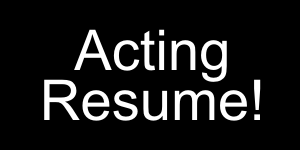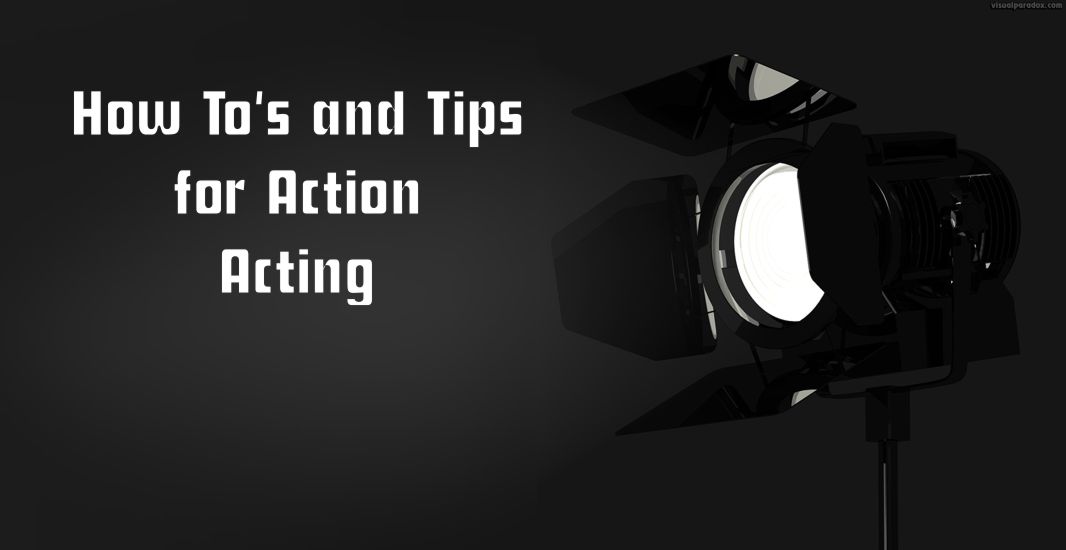 Unlike those in the 9-5 or corporate world, who only need a resume when changing jobs or bucking for a promotion, actors use this important tool on a regular basis. Every time an actor seeks representation from an agent, submits his picture for a “picture-pull” or goes on an audition, his acting resume must be up-to date, professional and set-up according to “industry standards”. A picture or “headshot” as it’s known in the business is used for identification purposes and to see your personality. A resume shows that you are a professional, that you have experience and training, and what (besides acting) you can do well.
Unlike those in the 9-5 or corporate world, who only need a resume when changing jobs or bucking for a promotion, actors use this important tool on a regular basis. Every time an actor seeks representation from an agent, submits his picture for a “picture-pull” or goes on an audition, his acting resume must be up-to date, professional and set-up according to “industry standards”. A picture or “headshot” as it’s known in the business is used for identification purposes and to see your personality. A resume shows that you are a professional, that you have experience and training, and what (besides acting) you can do well.
Many actors make the mistake of going to a business service center, such as Kinko’s to design their resumes. Although they are great for copying, cutting and such, they usually know nothing about building an acting resume. Unlike a business resume, acting resumes should never include career objectives, dates of employment, job descriptions, training/education or employment outside of the industry, references or the word “experience”. I saw a girl who listed Hooters under Experience because she worked there as a waitress. As a Casting Director, whenever I see these things on an actor’s resume, I knew that he or she was not a professional, has not been properly trained and unfortunately her opinion of them as an actor was instantly compromised. This same reaction is felt by agents, directors and producers, thus a well written resume is a must in this business.
There is an accepted standard by which to set up an acting resume. First of all your acting resume must fit neatly on the back of your headshot. Since pictures are 8×10 and paper is 81/2 x 11, your resume must be cut to size. It is easier if you set it up on your computer (type-written resumes are no longer acceptable) in the upper left hand corner, so that you only have to make two cuts rather than 4. Another option is to run them directly onto the back of your picture from a laser printer, but more about that later.
Your name should be in the center of the first line in a bold font size of at least 16-18. The less work you have the bigger the font should be. Under that, also centered but in a smaller type should be hair and eye color, height and weight. Next would be a phone number or two. Do not use your home number. Use a beeper or cell phone. Do not put your address or Social Security number. After the part is cast, everyone else’s headshots are thrown away. This puts your personal info (and a picture of you) into the hands of anyone willing to look through the garbage. I know of several actors and actresses who have been stalked, had their SS#’s used to get fraudulent credit cards and worse. If you are bi-lingual this should be listed next on your resume, also centered and in fairly large print.
The following categories should all start at the left margin. The first category (if this is for TV/Film or commercials) should be Film/TV. (Many people who also do theatre have a separate resume with Stage first, for theatre auditions only). Align the category name with the left margin then hit enter so that the first entry is at the margin as well. If you do not have any entries in a specific category, such as Film, do not put the category. I know this sounds like common sense but we see it all the time. All this does is call attention to the fact that you haven’t done any. In the first column you would list the name of the TV Show or Movie, then you would tab over a few inches to your next category which is for the role you played. It is acceptable to put extra work on your resume if you haven’t done any principle work, as it shows that you have worked on a set. You should not put “extra” as your part, but list whatever you portrayed in the scene such as “restaurant patron” or “party guest” etc. If you work more than one day on the same film, playing different types, only use one on your resume. If you had a speaking part you would list it as principle, under 5, guest star, co-star or lead. The next column (once again a few inches to the right) is for the production company or Studio. For example: Paramount, TriStar or even the name of an independant film company or University, if it is a student film. If it is TV, list the network ABC, FOX etc.
Do not necessarily list these chronologically, but by most impressive. A lead in a student film would definely take precedent over any extra work even on the biggest movie. But a principal role in a major film would be rated more highly then a co-star in an unheard-of indie. Once you have a good master copy, you may ask your agent if they’d like the order to be different. Don’t just go into them and ask “How should I do my resume?” It’s your job as an actor to know the set-up.
Next category would be Theatre. Here you would list the name of the play in the first column, the name of the character you played (such as Juliet) in the second and the name of the theatre (such as Peking Players) third. If you are in your early 20’s you may use high school theatre if you don’t have anything else, but people usually list it as (for example) Jackson Players, rather than Jackson High School. This is not lying, this is marketing.
After Theatre would be Commercials. If you are an experienced actor or in NY or LA, simply write “list available upon request”. That is an industry standard that any agent or casting director understands. If you’ve done a Coke commercial (as long as it’s not still running) you are free to do a Pepsi commercial, but the Pepsi clients might reject you if they see it on your resume, so instead you have a list which probably only your agent will ask for. If the Pepsi people ask you if you’ve ever done a Coke, don’t lie, but what they don’t know can’t hurt them. However if you are new and have only done a few local spots such as Psychic Solution or Joe’s Plumbing, go ahead and list them as it at least shows once again that you’ve worked on a set. In that case, you would have three columns Product (Psychic Solution) Role (Duped Caller just kidding, leave off the duped part) and Production Co (Star Productions).
Training comes next. This should be limited to training for acting and auditioning, which may include stage, TV/Film, Commercials, music, dance, voice and body, stage combat and anything else an actor would use in his career. College degrees in anything other than related fields need not be mentioned. Again it should not be listed chronologically but by “industry importance”. If you take a weekend on-camera auditioning workshop with a well known casting director, this will mean more to a client than your 2 years of acting training with a local acting teacher. This is not to say that you don’t need quality acting training in order to get the most out of these weekends. I’m simply talking about setting up your resume. Of course if you have a degree in acting from a respected college or University, this would rank above a five or six week class. Again set it up as you think it should be, then ask your agent to make alterations before doing a mass printing. Most actors won’t like hearing this, but I highly recommend that you attend at least one stunt camp during your career. Not only is it exciting and fun, but you can make some excellent industry contacts.
Special skills and Sports can be listed as one category or two and can be listed in columns (suggested if you don’t have much work) or on a line or two separated by commas. These should include any skill that might be needed in a Commercial, Film or TV show, that not everyone can do. You need not be a professional or olympian in the field but you must be able to do it well for a full day. Acceptable entries include rollerblading, languages spoken, firearms, improvisation, swimming, diving, golf, drive 5-speed etc. If you do any of them extremely well such as a great handicap in golf or 12 years of ballet put that in parentheses next to it. Things that shouldn’t be included are cooking (unless you’re a chef) sewing, computer skills etc because anyone can do these convincingly on TV.
Once your acting resume is completed, make copies and have them cut to 8×10 or have them printed on the back of your headshot. You can do this at home with a laser printer or at a facility like Kinko’s. I do not recommend printing too many at a time as hopefully you will keep getting jobs and updating it regularly. It is perfectly acceptable to hand-write your last booking on your resume until you are able to update it, but generally you should keep it current. Clients and agents won’t know what you’ve done if it’s not on there. If your resumes are separate, staple them to your headshot with one staple in each corner. This is much better than gluesticks or sprays which will come apart in humidity.
Last but not least, do not lie on your acting resume. You will eventually get caught and it will be very embarrassing. I had a friend who had major theatre, TV/Film and commercial credits but for some reason when she moved to NY she decided to list a play that she had been up for but didn’t get. She had really wanted the role as it was in a world premiere of an original play, but unfortunately after four callbacks, another woman got the part. She went on a film audition in NY where the producer interviewed her, with resume in hand. She looked my friend in the eye and said, “So you were in ‘such-and-such’ at the Dallas Theatre?” My friend smiled and said “Yes, it was wonderful”, at which point the producer exclaimed, “That’s amazing because my fiance wrote and directed it and I’VE NEVER SEEN YOU BEFORE”
Needless to say her audition was over.






